A pet list can help you choose the type of house pet that’s right for you. But you might need a jump start for your pet list—ideas to help you explore different types of animals—beyond a dog or a cat—that can keep you company at home. And when you’ve met your match but learn that it’s hundreds of miles away, don’t give up. We’ll explain how ground transportation for pets can help.
Before You Start Your Pet List
Are you ready for a pet? Before you add an animal to your pet list, consider your lifestyle and if it allows you to fulfill the commitments:
- Financial – Cost of care for a house pet includes food, veterinary expenses, medication, grooming, pet sitting, boarding, and more.
- Emotional – All house pets need some of your attention. Often, you’ll need to bond with the animal by petting it, talking to it, or holding it.
- Time – Grooming, veterinary visits, exercise, bathing, and feeding—maintaining a healthy pet takes time. Younger house pets and aging pets might require more time and attention.
- Environmental – Learn about each pet and the environment it needs. In addition to your living space, check homeowners’ association policies or renting or leasing contracts for restrictions on certain types of pets or breeds. And ensure the species and breeds on your list are legal to keep as house pets in your country or state.
Top Ten (10) Pet List
Ready for our top ten pet list? Dogs and cats are the most common house pets, so they take first and second place. Scroll on if you want to skip to number 3; we understand. But what can you expect by choosing a dog versus a cat?
1. Dog

Before you say, “You had me at woof,” to a cute little canine—before you make the purchase and arrange for dog shipping—get the facts on what it means to own a dog.
- Life span – According to the Journal of the American Veterinary Medical Association, a healthy dog can live 12 to 15 years depending on its breed.
- Care – Expect to feed, exercise, handle and groom your dog. Your dog will need housing, licensing, identification, spaying or neutering, vaccinations, and veterinary exams. For details, visit the American Society for the Prevention of Cruelty to Animals website and read the general dog care page. Overall, dogs require more time, attention, and exercise than cats.
- Breeds – According to the American Kennel Club (AKC), there are more than 340 known dog breeds. Although dogs are generally friendly, each breed has its characteristics and needs. Visit the AKC website to learn about different dog breeds, their temperament, and their health.
- Cost of Care – Before you add a specific dog breed to your pet list, consider the cost of care. Factors that influence the yearly cost of caring for your house pet can include the breed, pedigree, certification, and the dog’s age. In addition to food and grooming costs, depending on the dog’s breed, The Simple Dollar estimates that you can expect to spend $400-$1500 each year for medical care.
2. Cat



Are you a cat lover? Get the facts before you purr back to a prospective kitty on video, adopt or purchase it, and have it shipped to your home. Although pet transportation services can bring your cat home in style, don’t disappoint your new house pet by misunderstanding what’s involved in taking care of it. After doing research, you can narrow your pet list with cat breeds that work for your environment and lifestyle.
- Life span – An indoor cat can live 12 to 18 years. If you let your cat roam outdoors, its life expectancy may be shorter.
- Care – If you choose a cat as your house pet, make a schedule for feeding it and playing with it for exercise. Thick- or long-haired cats need regular grooming. And to keep your cat healthy, you’ll clean its litter box regularly. Unlike most dogs that benefit from outdoor exercise, reduce your cat’s risk of injury and disease by keeping it indoors, unless it’s on a leash and walking with you. Scratching posts and plenty of places to rest and stretch indoors are essential if you choose to adopt or buy a cat.
- Breeds – Cats can be confident and friendly, shy and reserved, or adventurous and playful house pets. You can visit Purina’s website for a list of cat breeds and facts about their history, health, characteristics, and life span.
- Cost of Care – In addition to the cost of food, grooming, and litter, expect medical expenses. According to Pet Finder, first-year expenses for your new house pet are $405 to $2285. Expect to spend $340 to $1825 each following year.
After you’ve selected the perfect cat or dog for your home, be patient. There might be a waiting list for a puppy or kitten if you’re getting your house pet from a responsible breeder. As an alternative, make a note on your pet list to think about the joy of pet adoption. Pet Finder is one reliable resource for pet adoption.
Dogs and cats aside. It’s the moment you’ve been waiting for—house pets 3 through 10.
3. Parrot
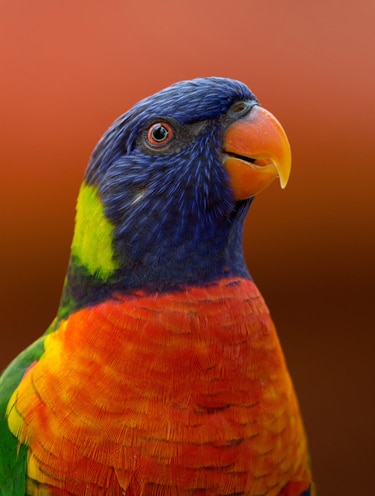


If you want a feathered friend for your pet list, parrots are playful, lively, colorful house pets. With more than 350 species, you can find one that is suitable as a pet and matches your interests. How do you take care of a parrot?
- Life span – Depending on the species, parrots live ten to 60 years.
- Care – Parrots can be affectionate. Your bird will be happy if you pet it, hold it, and talk to it. It’s fun to listen as it mimics voices and sounds that it’s heard in your home. PetSmart recommends that you spend at least two hours each day with your parrot. Get a cage large enough for the parrot to stretch its wings, climb, perch, play—or even take a short flight. Find out why the Association of Avian Veterinarians says that toys are essential to caring for your parrot.
- Species – Although most species like warm weather, some prefer a cold climate. Some species don’t react well to children’s quick movements. If a parrot is at the top of your pet list, prepare to supervise your children while they spend time with it.
- Cost of care – The price of a parrot varies by species—from $10 to $5000 or more. Other than the cost of a cage, food, and other items to keep your bird singing—or talking—the first-year cost of care is about $300. Plan to spend about $200 each following year. The Spruce Pets recommends that you budget for unexpected visits to the vet. Your cost for supplies and care will vary with the species and their needs.
If you choose an exotic bird from a land far, far away, pet transportation services can pick up the bird at an airport and deliver it to your door.
4. Fish
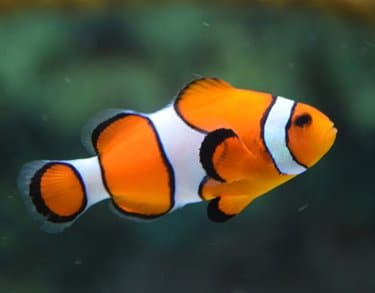


Caring for a pet fish can be as simple—or as complicated—as you would like. Think about adding fish to your pet list if you live in an apartment, have limited space for a house pet, or have allergies or sensitivities to most pets. The flowing water of the tank, the colors of the fish, and the plants and rocks in an aquarium help reduce stress.
- Life span – While most tropical fish live three to five years, a goldfish can live ten years or longer.
- Care – Keeping fish healthy requires the right aquarium, filter, food, and environment. Before you invest in fish, research the breed, and understand how to care for them properly. Educate yourself on how to clean the tank, perform water changes, and acclimate new fish.
- Breed – The habits and characteristics of fish vary. Learn which fish are schoolers, cleaners, or predators to achieve the right balance in your tank. Fishkeeping World is a hobbyist’s website that can guide you in selecting fish based on your interests and skill level.
- Cost of care – Setup costs range from $85 to more than $6000 depending on fish type, aquarium size, and display. The yearly cost of caring for your finned friends can be as low as $30—or exceed $1000. Saltwater fish and aquariums are more expensive to maintain.
5. Reptile
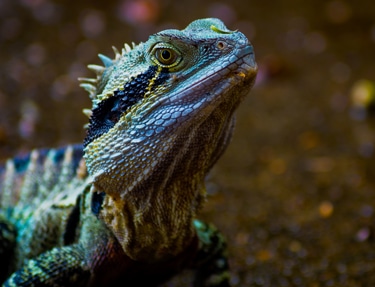


If you’re looking for a low-maintenance critter for your pet list, reptiles represent. They require less exercise and care than dogs, cats, and many other house pets. Small lizards and turtles are an excellent introduction to having a reptile for a pet.
Life span – Lizards can live two to 20 years, and turtles can live for more than 20 years.
Care – Thoroughly educate yourself about proper care for the reptile you choose. Improper diet, handling, lighting, or environment can make your pet sick. The level of care required varies depending on your pet choice. Reptiles might eat insects, vegetables, or meat. Visit Reptile Magazine for a beginner’s guide for reptile care.
Species – Some reptiles enjoy being held by humans, while others prefer to be left alone. The American Veterinarians Medical Association recommends that you practice good hygiene when handling reptiles to avoid contracting Salmonella—which is commonly carried by many reptiles. If you’re interested in a specific reptile, before adding it to your pet list, research it to learn how large it may grow.
Cost of care – First-year costs, including the price of the pet, can range from $300 to $800 or more. According to a Pet Place article, annual expenses for a reptile house pet, including food, vitamins, supplies, and veterinary care range from $250 to $400. The cost can vary with the type of reptile you choose and how much you want to cater to it. Pet transportation services will safely ship your pet reptile from the seller to your door.
6. Amphibian
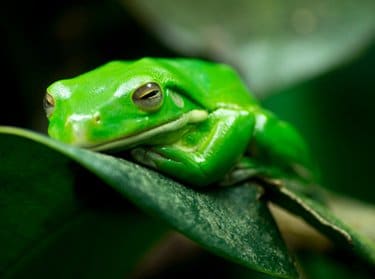


Many amphibians—including frogs and salamanders—are low maintenance and don’t need much living space. A ten- or 20-gallon tank is usually plenty of room. If you want a house pet but live in an apartment or have limited space for a pet—take the leap. Add a frog or another amphibian to your pet list.
- Life span – Depending on its species, your amphibian house pet can live five to 15 years.
- Care – Amphibians need a vivarium (a container that mimics a natural habitat) with bedding and small tree limbs. You’ll need supplies to maintain the right lighting, temperature, and humidity. Their diet can include crickets or small mice. Amphibians are often carriers of Salmonella, so practice good hygiene as you care for your house pet and regularly clean the vivarium and replace the bedding.
- Species – Frogs grow from two to ten inches depending on their species. The average growth for a salamander is six to 12 inches.
- Cost of care – The average price of setup is $100 to $400. The yearly cost of feeding the pet, refreshing its habitat, and veterinary care is $100 to $250. It costs more to maintain some exotic amphibians. If you’re investing in a house pet that must be handled with care, choose a reliable pet transportation service to deliver it to you.
For a veterinarian’s viewpoint, read the article, Befriending Reptiles and Amphibians, on the American Veterinary Medical Association website.
7. Hermit Crab



Hermit crabs can be fun-to-watch house pets. They are low-maintenance, quiet clawed friends. But they love the sand and their hermit crab friends, so be prepared to buy more than one, give them space, and mimic the environment they love. If you don’t want to own more than one hermit crab, you probably shouldn’t add it to your pet list.
- Life span – Hermit crabs can live up to 30 years in their natural environment. If you have them as house pets and take good care of them, your hermit crabs can live up to ten years. They will thrive if you keep them in a sandy environment.
- Care – Set up a vivarium with proper heating, lighting, temperature, and plenty of sand. Your crabs will eat veggies, tropical fruit, or pellet food. Regularly clean the vivarium. You can download a hermit crab care sheet from Fluker Farms.
- Species – Hermit crabs are active, social—especially in the evenings—and love to burrow in the sand. They thrive in an environment with their companions, so plan to purchase at least two. Their average size is one to five inches.
- Cost of care – Give your hermit crabs the right environment with plenty of room to roam in the sand. Plan on initial setup costs of at least $300-$400. You’ll spend about $25 per month on food and maintaining a clean environment.
8. Rabbit



Rabbits are cute, responsive, quiet house pets. But they can have vivid personalities and know how to get your attention by tapping their paws on the floor. If you like the words, “soft and cuddly,” add a rabbit to your pet list.
- Life span – A rabbit can live five to ten years.
- Care – As a house pet, your rabbit will enjoy your attention. You’ll need to bathe it and give it room to hop around and exercise. It will also need plenty of vegetables or rabbit pellets and freshwater. Keep it in a comfy rabbit cage overnight. And keep it healthy with checkups at the vet.
- Breeds – The U.S. is home to more than 60 kinds of rabbits. Depending on its breed, your bunny can grow up to 13 pounds.
- Cost of care – Initial setup cost is $150 to $300. Plan to spend about $30 each month on food, $75 for yearly vet exams, and $100 to $250 to have your house pet spayed or neutered.
9. Chinchilla
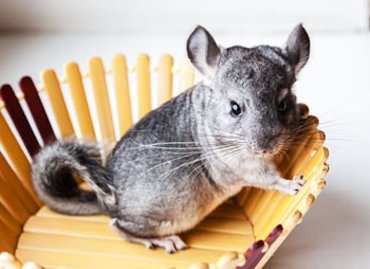


Chinchillas are chunky, charming little furballs with dominant eyes and ears and a bushy tail. Like a kangaroo, its front legs are shorter than its back legs. If you’re thinking about a rodent for your pet list, you might want to give this plush mammal a chance.
- Life span – Chinchillas live an average of ten to 12 years.
- Care – In the wild, chinchillas are vegetarians. But as a house pet, expect to feed your chinchilla a diet of commercially made pellets to give it the nutrition it needs. A warm climate will keep your house pet comfortable. Clean its cage frequently. Chinchillas are fragile and require gentle care. If you have young children at home, will they be gentle enough to avoid harming the pet? Think about it before adding a chinchilla to your pet list. Visit The Spruce Pets website for information on how to care for a chinchilla.
- Species – There are two species of chinchillas. They are clean and odorless. Chinchillas enjoy resting during the day and being active at night. If you come home from a long day, a chinchilla will greet you and cheer you up with its playfulness.
- Cost of care – Chinchillas need a large cage with a water bottle and places to run, jump, swing, and hide. Toys and platforms will help to keep it amused. The pet can cost $150 to $300. The setup cost for its habitat is $400 to $800. Yearly care, including food, refreshing the habitat, veterinary care, and other expenses, is about $400 to $600.
10. Snail



Snails are often forgotten and overlooked on a pet list. But they are quiet and unique, and they don’t require a complicated setup. Check state and federal regulations to avoid buying snails that are illegal to keep as pets. Some snails harbor parasites that transmit diseases to humans and animals, so thoroughly research different species before choosing one.
- Life span – Depending on the species, pet snails can live one to ten years or longer.
- Care – Snails need an environment with algae, plants, branches, high humidity, low sunlight, and places to hide. You’ll need to maintain the right PH in the water for freshwater snails. Most snails eat small amounts of vegetables and some fruits, but some of them are meat-eaters. Supplement their diet with calcium to keep their shell strong and healthy. Clean the habitat weekly.
- Species – More than 60,000 species exist in the world, including land, sea, and freshwater snails. Snail length varies from a few centimeters to 12 inches. Most North American pet snails are a half-inch to three inches long. They are active at night.
- Cost of care – Setup costs include an aquarium (freshwater snail) or a vivarium (land snail) and supplies to provide the right environment, humidity, temperature, and lighting. Depending on the size of the habitat, set up can cost $60 to $100. It will cost about $10 per month to feed a snail and refresh it’s living space.
Summary



- Before adding an animal to your pet list, research its needs, characteristics, and cost of care.
- Determine if the animal is right for your budget, lifestyle, and home environment. Ask about community, federal, or state restrictions against specific breeds or species.
- Visit the American Veterinary Medical Association website, and read the article, Selecting a Pet for Your Family.
- Find a reputable breeder or seller.
- Decide if you want pet transportation services to deliver your pet to you.
- Purchase or adopt your house pet.
- Prepare accommodations for the pet before it arrives.
Will the Winner on Your Pet List Need Transport?
Pet Van Lines has more than 15 years of experience transporting pets. We provide nationwide ground transportation for dogs, cats, and all types of house pets. You can trust us with your number one pet.
How can we help you?
- Provide ground transportation for your new pet if airline policy won’t accommodate it—or if you prefer not to have your pet in plane cargo
- Retrieve your pet from an airline and transport it to you in a climate-controlled vehicle
- Pick up your new pet from a breeder or seller and deliver it to you
- Entrust your pet to an attentive driver who will feed and exercise your pet during travel
Request a quote on our website or call us to discuss your pet shipping needs.
